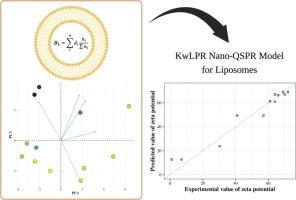Computational and Structural Biotechnology Journal ( IF 6 ) Pub Date : 2024-01-24 , DOI: 10.1016/j.csbj.2024.01.012 Tomasz Puzyn , Krzesimir Ciura , Kamila Jarzynska , Agnieszka Gajewicz-Skretna

|
Liposomes, nanoscale spherical structures composed of amphiphilic lipids, hold great promise for various pharmaceutical applications, especially as nanocarriers in targeted drug delivery, due to their biocompatibility, biodegradability, and low immunogenicity. Understanding the factors influencing their physicochemical properties is crucial for designing and optimizing liposomes. In this study, we have presented the kernel-weighted local polynomial regression (KwLPR) nano-quantitative structure-property relationships (nano-QSPR) model to predict the zeta potential (ZP) based on the structure of 12 liposome formulations, including 1,2-dioleoyl-sn-glycero-3-phosphoethanolamine (DOPE), 3ß-[N-(N',N'-dimethylaminoethane)-carbamoyl]cholesterol (DC-Chol), 1,2-dioleoyl-3-trimethylammonium-propane (DOTAP), and L-α-phosphatidylcholine (EPC). The developed model is well-fitted ( = 0.96, = 5.76), flexible ( = 0.83, = 10.77), and reliable (= 0.89 = 5.17). Furthermore, we have established the formula for computing molecular nanodescriptors for liposomes, based on constituent lipids’ molar fractions. Through the correlation matrix and principal component analysis (PCA), we have identified two key structural features affecting liposomes’ zeta potential: hydrophilic-lipophilic balance (HLB) and enthalpy of formation. Lower HLB values, indicating a more lipophilic nature, are associated with a higher zeta potential, and thus stability. Higher enthalpy of formation reflects reduced zeta potential and decreased stability of liposomes. We have demonstrated that the nano-QSPR approach allows for a better understanding of how the composition and molecular structure of liposomes affect their zeta potential, filling a gap in ZP nano-QSPR modeling methodologies for nanomaterials (NMs). The proposed proof-of-concept study is the first step in developing a comprehensive and computationally based system for predicting the physicochemical properties of liposomes as one of the most important drug nano-vehicles.
中文翻译:

从脂质体结构预测其 Zeta 电位:DOPE、DC-Chol、DOTAP 和 EPC 制剂的 Nano-QSPR 模型
脂质体是由两亲性脂质组成的纳米级球形结构,由于其生物相容性、生物可降解性和低免疫原性,在各种药物应用中具有广阔的前景,特别是作为靶向药物递送中的纳米载体。了解影响其理化性质的因素对于设计和优化脂质体至关重要。在本研究中,我们提出了核加权局部多项式回归 (KwLPR) 纳米定量结构-性质关系 (nano-QSPR) 模型,用于根据 12 种脂质体制剂的结构预测 zeta 电位 (ZP),其中包括 1、 2-二油酰基-sn-甘油-3-磷酸乙醇胺 (DOPE)、3ß-[N-(N',N'-二甲基氨基乙烷)-氨基甲酰基]胆固醇 (DC-Chol)、1,2-二油酰基-3-三甲基铵-丙烷(DOTAP)和 L-α-磷脂酰胆碱(EPC)。开发的模型拟合良好(= 0.96,= 5.76), 灵活 (= 0.83,= 10.77),并且可靠(= 0.89= 5.17)。此外,我们还根据脂质成分的摩尔分数建立了计算脂质体分子纳米描述符的公式。通过相关矩阵和主成分分析(PCA),我们确定了影响脂质体zeta电位的两个关键结构特征:亲水亲油平衡(HLB)和形成焓。较低的 HLB 值表明亲脂性更强,与较高的 zeta 电位相关,因此也与稳定性相关。较高的形成热反映了 zeta 电位的降低和脂质体稳定性的降低。我们已经证明,纳米 QSPR 方法可以更好地了解脂质体的组成和分子结构如何影响其 zeta 电位,填补了纳米材料 (NM) ZP 纳米 QSPR 建模方法的空白。所提出的概念验证研究是开发基于计算的综合系统的第一步,该系统用于预测脂质体作为最重要的药物纳米载体之一的理化性质。



























 京公网安备 11010802027423号
京公网安备 11010802027423号